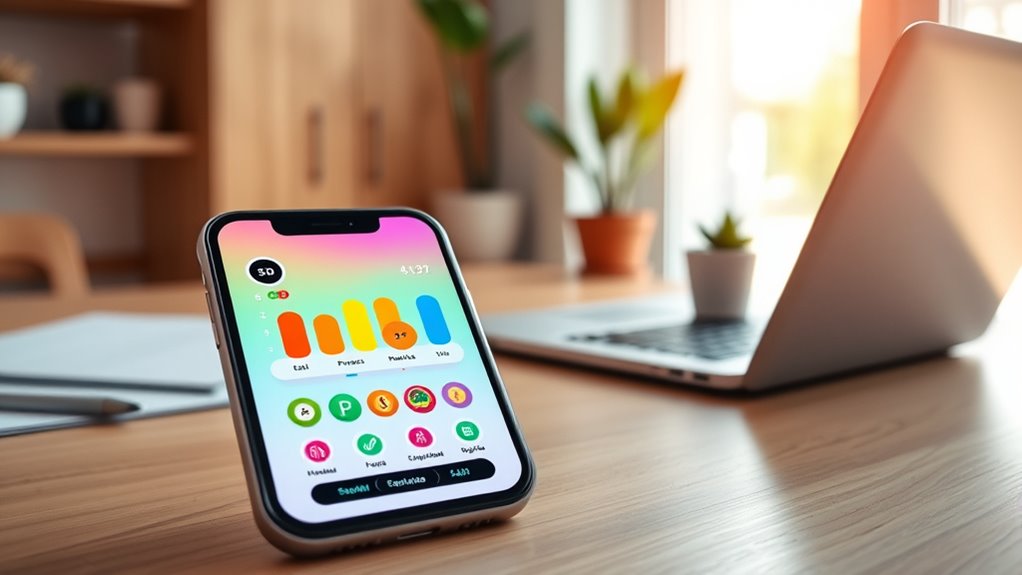Gamifying your personal finance habits makes managing money more fun and motivating by turning tasks like saving and budgeting into engaging challenges. You can set rewards for reaching milestones and track your progress with visual tools like charts or progress bars. This approach helps reinforce positive behavior, keeps you focused, and makes financial goals feel more achievable. Keep exploring, and you’ll discover easy ways to transform your money habits into an enjoyable, rewarding journey.
Key Takeaways
- Incorporate reward systems to motivate consistent saving and budgeting habits.
- Use progress tracking tools like charts and progress bars to visualize financial goals.
- Turn financial tasks into engaging challenges with badges or levels to encourage ongoing effort.
- Customize incentives to suit personal preferences, making habit formation more appealing.
- Combine visual progress and rewards to create positive feedback loops that sustain motivation.

In today’s world, turning personal finance into a game can make saving and budgeting more engaging and less overwhelming. Instead of viewing money management as a tedious chore, you can transform it into a fun challenge by incorporating reward systems and progress tracking. Reward systems motivate you to stick with your financial goals by offering incentives for reaching milestones. Whether it’s a small treat, a new gadget, or a special outing, these rewards give you something to look forward to and reinforce positive habits. By setting clear, achievable goals and rewarding yourself when you hit them, you create a sense of accomplishment that keeps you motivated.
Turning personal finance into a game makes saving fun and motivating with rewards and progress tracking.
Progress tracking is another essential element in gamifying your finances. When you systematically monitor your savings, expenses, and debt reduction, you see tangible evidence of your efforts. Using apps or spreadsheets, you can chart your progress over days, weeks, or months. Visual representations like charts or progress bars make it easy to understand how far you’ve come and what’s left to achieve. This continuous feedback loop keeps you engaged and aware of your financial journey, turning what might seem like a slow process into a series of small wins.
Implementing reward systems and progress tracking together creates a feedback loop that encourages consistent effort. For example, if you set a goal to save a certain amount each month, tracking your savings progress visually motivates you to stay on course. When you see your savings grow on a chart, you’re more likely to continue making disciplined choices. Reward yourself once you reach a milestone—perhaps a dinner out or a new book—so you associate positive feelings with responsible money habits. This approach transforms the often intimidating task of budgeting into a game-like experience, where each step forward feels like a victory.
Furthermore, you can customize your reward system to suit your personality and preferences. Some may prefer small daily rewards for routine savings, while others might aim for larger rewards after significant milestones. The key is to make the rewards meaningful enough to motivate you without derailing your progress. Progress tracking tools, whether digital or manual, help keep your goals front and center, reminding you of your journey and encouraging you to push through challenges. Incorporating mindfulness techniques can also help you stay focused and present during your financial planning, reducing impulsive decisions and fostering a more thoughtful approach to money management. When you combine these elements, managing your finances becomes less of a chore and more of an engaging game where you’re the hero, steadily moving toward financial stability.
Frequently Asked Questions
How Can Gamification Improve Long-Term Financial Discipline?
You can improve your long-term financial discipline by using gamification, which promotes behavior modification and habit formation. By turning saving and budgeting into a game, you stay motivated and engaged, making it easier to develop consistent habits. Rewards, progress tracking, and challenges encourage you to stick with your financial goals. Over time, this playful approach helps solidify positive behaviors, making disciplined financial habits feel more natural and sustainable.
What Are the Best Apps for Gamified Budgeting?
Did you know 60% of people struggle with budgeting challenges? To make it easier, try apps like YNAB or Qapital, which turn budgeting into fun savings competitions. These apps help you stay motivated by rewarding progress, making it easier to stick to your financial goals. With gamified features, you’ll enjoy managing your money more and build better habits over time.
Can Gamification Help Reduce Impulse Spending Effectively?
Gamification can effectively help you reduce impulse spending by boosting your motivation strategies. When you turn saving and budgeting into a game, you’re more likely to stay committed and make mindful choices. By setting rewards and challenges, you reinforce positive behavior change. This engaging approach keeps you motivated, making it easier to resist impulse purchases and develop healthier financial habits over time.
How Do Rewards in Gamification Impact Motivation?
You might think rewards only boost short-term motivation, but they actually support behavioral reinforcement, encouraging consistent effort. When rewards align with your goals, they strengthen intrinsic motivation, making good habits feel more rewarding naturally. This positive feedback loop helps you stay engaged and committed. So, rewards aren’t just extrinsic motivators—they deepen your internal drive, making it easier to maintain healthy financial behaviors over time.
Are There Any Risks Associated With Gamifying Personal Finance?
When you consider risks, data privacy is a key concern, as personal financial info might be vulnerable to breaches. Additionally, gamification can sometimes lead to addiction risks, causing you to focus too much on rewards rather than financial health. You should weigh these risks carefully, ensuring the tools you use prioritize your privacy and promote healthy habits instead of fostering dependency or exposing your sensitive data.
Conclusion
By turning your financial goals into a game, you’re planting seeds in a garden that thrives with each small win. Every saved dollar and smart choice adds a new bloom, making your progress feel like a vibrant, ongoing adventure. Remember, managing money is a journey—think of it as steering a ship through calm and stormy seas. Keep playing, stay engaged, and watch your financial landscape blossom with confidence and success.









